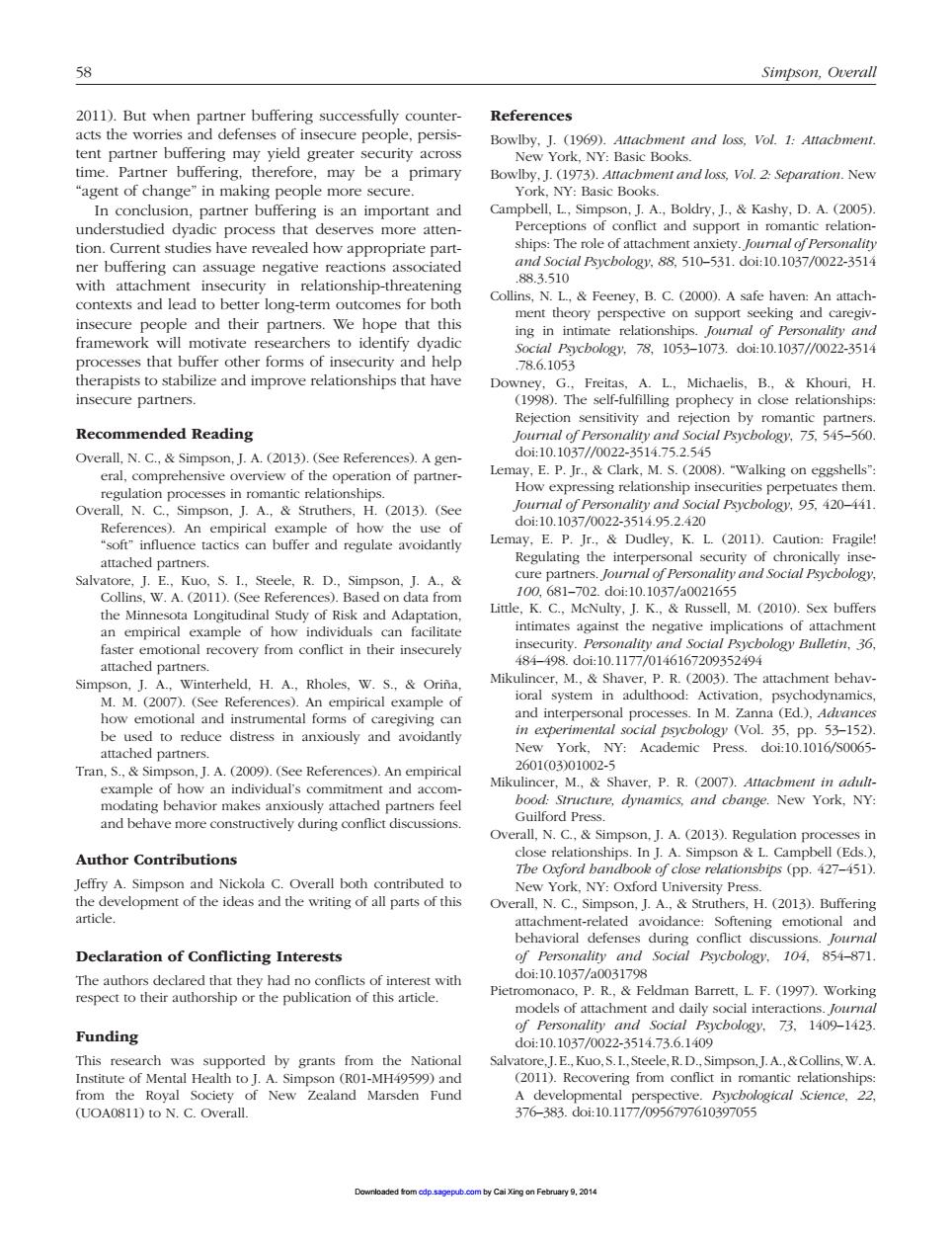正在加载图片...

58 Simpson,Overall 2011).But when partner buffering successfully counter. References acts the es and defense paner buffering may yield greater secunpriman Bowlby.I.(1969).Attacbment and loss.Vol.1:Attacbment York,NY "agent of change"in making people more secure. York.NY:Basic Books. In conclusion,partner buffering is an important and Campbell.L Simpson.J.A.Boldry.J&Kashy,D.A.(2005) understudied dyad process tha deserves more atten ships:The role of attachment anxicty. with attachment insecurity in relationship-threatening 0a6es510-531.dot101057/o02351 contexts and lead to better long-term outcomes for both Collins,N.L Feeney,B.C.(2000).A safe haven:An attach that this to id nd heln therapists to stabilize and improve relationships that have I Michaelis.B.. Khouri H insecure partners. Recommended Reading do:10.1 37/002 romantic relationships (2013).(se on0l8g702ealPchakg95420-4n Referen Lemay,E.P.Jr.Dudley.K.L(2011).Caution:Fragilet Salvatore.E Kuo S.1.Steele,R.D..Simp A.& 100.681-702.d0t10.1037/a0021653 ,w.A.(2011 nce Based o Little.K.C..MeNulty.J.K..Russe M.(2010).Sex buffers Simpson,J.A..Winterheld,H.A..Rholes,W.5.&Orina Mikul ioral system in adulthood:Activation, tional and ences).An empi cal example c 5.In M be used to reduce distress in anxiously and avoidantly Tran. York.NY:Academic Press.doi:0101/s0065 C2000)(see References).An e Overall.N.C..Si I.A.(2013).Regulation Author Contributions close re ips..Simpson Jeffry A.Simpson and Nickola C.Overall both ontributed to evelopment of the ideas and ofll pats Overall.N.C..Simpson.J.A..Strutl s.H.(2013).Buffering Declaration of Conflicting Interests Social Psycbology.104.854-871 The authors declared that they had no conflicts of interest with respect to their authorship or the publication of this article. Pietromonaco,P.R.Feldman Barrett,L F.(1997).Working Funding 1010.10370022.3514736.140 This research was supported by grants from the National 36oti0176961090 logical Science,22, (UOA0811)to N.C.Overall. u2014 58 Simpson, Overall 2011). But when partner buffering successfully counteracts the worries and defenses of insecure people, persistent partner buffering may yield greater security across time. Partner buffering, therefore, may be a primary “agent of change” in making people more secure. In conclusion, partner buffering is an important and understudied dyadic process that deserves more attention. Current studies have revealed how appropriate partner buffering can assuage negative reactions associated with attachment insecurity in relationship-threatening contexts and lead to better long-term outcomes for both insecure people and their partners. We hope that this framework will motivate researchers to identify dyadic processes that buffer other forms of insecurity and help therapists to stabilize and improve relationships that have insecure partners. Recommended Reading Overall, N. C., & Simpson, J. A. (2013). (See References). A general, comprehensive overview of the operation of partnerregulation processes in romantic relationships. Overall, N. C., Simpson, J. A., & Struthers, H. (2013). (See References). An empirical example of how the use of “soft” influence tactics can buffer and regulate avoidantly attached partners. Salvatore, J. E., Kuo, S. I., Steele, R. D., Simpson, J. A., & Collins, W. A. (2011). (See References). Based on data from the Minnesota Longitudinal Study of Risk and Adaptation, an empirical example of how individuals can facilitate faster emotional recovery from conflict in their insecurely attached partners. Simpson, J. A., Winterheld, H. A., Rholes, W. S., & Oriña, M. M. (2007). (See References). An empirical example of how emotional and instrumental forms of caregiving can be used to reduce distress in anxiously and avoidantly attached partners. Tran, S., & Simpson, J. A. (2009). (See References). An empirical example of how an individual’s commitment and accommodating behavior makes anxiously attached partners feel and behave more constructively during conflict discussions. Author Contributions Jeffry A. Simpson and Nickola C. Overall both contributed to the development of the ideas and the writing of all parts of this article. Declaration of Conflicting Interests The authors declared that they had no conflicts of interest with respect to their authorship or the publication of this article. Funding This research was supported by grants from the National Institute of Mental Health to J. A. Simpson (R01-MH49599) and from the Royal Society of New Zealand Marsden Fund (UOA0811) to N. C. Overall. References Bowlby, J. (1969). Attachment and loss, Vol. 1: Attachment. New York, NY: Basic Books. Bowlby, J. (1973). Attachment and loss, Vol. 2: Separation. New York, NY: Basic Books. Campbell, L., Simpson, J. A., Boldry, J., & Kashy, D. A. (2005). Perceptions of conflict and support in romantic relationships: The role of attachment anxiety. Journal of Personality and Social Psychology, 88, 510–531. doi:10.1037/0022-3514 .88.3.510 Collins, N. L., & Feeney, B. C. (2000). A safe haven: An attachment theory perspective on support seeking and caregiving in intimate relationships. Journal of Personality and Social Psychology, 78, 1053–1073. doi:10.1037//0022-3514 .78.6.1053 Downey, G., Freitas, A. L., Michaelis, B., & Khouri, H. (1998). The self-fulfilling prophecy in close relationships: Rejection sensitivity and rejection by romantic partners. Journal of Personality and Social Psychology, 75, 545–560. doi:10.1037//0022-3514.75.2.545 Lemay, E. P. Jr., & Clark, M. S. (2008). “Walking on eggshells”: How expressing relationship insecurities perpetuates them. Journal of Personality and Social Psychology, 95, 420–441. doi:10.1037/0022-3514.95.2.420 Lemay, E. P. Jr., & Dudley, K. L. (2011). Caution: Fragile! Regulating the interpersonal security of chronically insecure partners. Journal of Personality and Social Psychology, 100, 681–702. doi:10.1037/a0021655 Little, K. C., McNulty, J. K., & Russell, M. (2010). Sex buffers intimates against the negative implications of attachment insecurity. Personality and Social Psychology Bulletin, 36, 484–498. doi:10.1177/0146167209352494 Mikulincer, M., & Shaver, P. R. (2003). The attachment behavioral system in adulthood: Activation, psychodynamics, and interpersonal processes. In M. Zanna (Ed.), Advances in experimental social psychology (Vol. 35, pp. 53–152). New York, NY: Academic Press. doi:10.1016/S0065- 2601(03)01002-5 Mikulincer, M., & Shaver, P. R. (2007). Attachment in adulthood: Structure, dynamics, and change. New York, NY: Guilford Press. Overall, N. C., & Simpson, J. A. (2013). Regulation processes in close relationships. In J. A. Simpson & L. Campbell (Eds.), The Oxford handbook of close relationships (pp. 427–451). New York, NY: Oxford University Press. Overall, N. C., Simpson, J. A., & Struthers, H. (2013). Buffering attachment-related avoidance: Softening emotional and behavioral defenses during conflict discussions. Journal of Personality and Social Psychology, 104, 854–871. doi:10.1037/a0031798 Pietromonaco, P. R., & Feldman Barrett, L. F. (1997). Working models of attachment and daily social interactions. Journal of Personality and Social Psychology, 73, 1409–1423. doi:10.1037/0022-3514.73.6.1409 Salvatore, J. E., Kuo, S. I., Steele, R. D., Simpson, J. A., & Collins, W. A. (2011). Recovering from conflict in romantic relationships: A developmental perspective. Psychological Science, 22, 376–383. doi:10.1177/0956797610397055 Downloaded from cdp.sagepub.com by Cai Xing on February 9, 2014